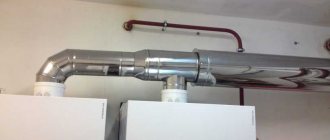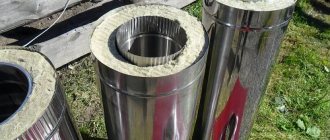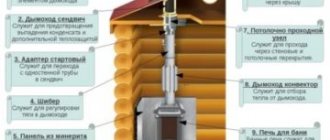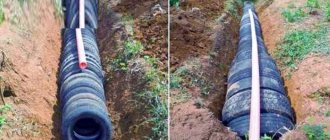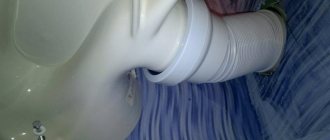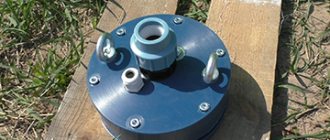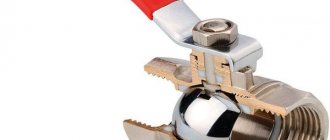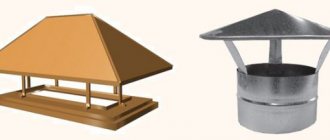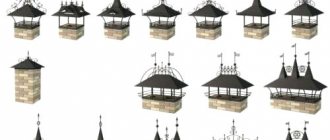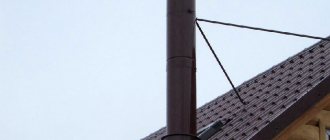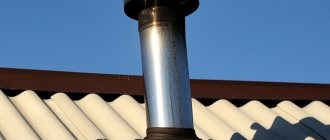Multi-baker Redmond RMB-611
2172 ₽ More details
Multi-baker Redmond RMB-611
2172 ₽ More details
Mixers
Ventilation systems in private houses and bathhouses must be equipped with smoke exhausters. These devices are used to remove smoke, dust and other impurities from the air. Without them, no hood can be organized. Modern ventilation systems allow the use of a wide variety of units.
Calculation and selection of a smoke exhauster.
Of course, a smoke exhauster can always be purchased at a specialized store, but there is an alternative way out of the situation. For example, you can make a smoke exhauster with your own hands. There is nothing complicated here. The most important thing is to acquire all the necessary tools and materials and follow the instructions presented below.
The principle of operation of the stabilizer
If the draft force in the system begins to exceed its optimal values, then a valve opens in the regulator, which reduces the pressure and thermal lift force due to the air coming from the room and mixing with the flue gases. The valve will remain open until the temperature drops and reaches the optimal level. Next, the valve will automatically close and the chimney system will continue to function properly.
This method of maintaining normal traction is simple and effective. Fuel in a stove or boiler will be burned evenly and consumed economically.
Installing a chimney draft stabilizer provides the following advantages:
- increasing the operational safety of the chimney system;
- reducing the amount of harmful substances released into the atmosphere;
- better air circulation when the valve is kept slightly open;
- the ability to operate on both forced and natural draft;
- uniform combustion of fuel in the boiler, which makes it impossible for the chimney to overheat;
- protection from strong gusts of wind;
- no burning smell in the room;
- increasing the service life of the smoke exhaust channel;
- preventing heat loss;
- possibility of installation in modern low-temperature boilers;
- ensuring fuel savings of 15-20%.
Tips for use
Moving parts are regularly maintained and lubricated, and accumulated particles are removed from the hopper. At the end of the chimney, protection from rain and snow must be installed.
Synchronous connection with the heating and ventilation control system will greatly facilitate boiler maintenance.
Using a boiler hood in a private home is convenient and practical, so this simple device can be recommended to a wide range of users.
Source
Installing the deflector
Once installed, the deflector is bolted to the roof to prevent it from being blown away by the wind.
Homemade and purchased models are assembled into a finished product at the bottom, before installation on the pipe. The aerodynamic structure is bolted to a round metal asbestos pipe; usually, 3 holes are made in the pipe for this purpose. If there is slight play, a clamp is used.
An adapter is used to mount the deflector in a brick pipe of rectangular or square cross-section. The device is tested after installation. The spark arrestor is made independently from a thin metal mesh or stainless steel sheet.
Preparation of materials
To assemble such a smoke exhauster with our own hands, we will need the following materials:
- Ready-made electric motor model;
- Mesh metal element with a thick base and snail;
- Fasteners (nuts and bolts);
- One sheet of metal and a drill;
- Scissors for cutting metal and a grinder;
- Tiles made of cast iron.
Which chimney is better for a solid fuel boiler?
A nuance: the operation of the smoke exhauster in a factory-installed boiler is coordinated with the combustion process and is controlled by an electronic unit. When installing a fan unit on a “brainless” heater, such consistency is excluded; you need to buy an automation unit or adjust the speed manually.
We list the situations when a smoke exhauster will help improve the operation and maintenance of a solid fuel heat generator:
- problems with draft - blowing by the wind, air pockets in the gas duct, many turns, narrowing of the diameter;
- due to the design features, the boiler smokes into the room when the door is opened;
- the height of the chimney is insufficient or the cut of the pipe fell into the wind support zone behind the ridge of the roof or another building;
- Cracks have appeared in the brick pipe, from which smoke is leaking.
It is better to operate the V. G. Kholmov mine heat generator with a traction fan
Some wood boiler designs (for example, shaft type) tend to emit smoke through an open loading hatch. A similar picture is observed in heat generators with a three-pass fire-tube heat exchanger of high resistance. The solution to the problem is to install a traction or blowing machine controlled by a controller.
Strengthening natural draft with the help of a smoke exhauster also has a downside. If, after warming up the pipe, natural exhaust has not been restored, the unit cannot be turned off - you may get burned. Now imagine that in the middle of the night the power supply goes out and the fan stops. While the chain thermostat closes the damper, smoke will fill the boiler room.
When the traction turbine is integrated into the heat generator by the manufacturer, such questions do not arise. Adding an exhaust fan to a conventional direct combustion boiler is another matter. You need to understand that in this case, the smoke exhauster solves only 1 problem - creating a vacuum in the firebox and increasing draft. There are a number of negative points here:
- Without an electronic control unit, performance will have to be adjusted manually. Automatic maintenance of coolant temperature is excluded.
- When air is supplied through the open ash chamber door, the fan will force the boiler to operate at maximum. Setting up a long burn mode will not be easy.
- In the event of an emergency stop of the impeller, fuel combustion will not stop, since gases pass freely through the volute or the body of the smoke exhauster. Air enters the firebox, increasing the likelihood of overheating.
- The impeller and internal surfaces of the unit become covered with soot, which must be removed. The rate of sticking depends on the moisture content and resin content of the wood.
Blowing machines always work in conjunction with a controller, so the problems listed above do not exist:
- the blower changes performance and turns off at the command of the control unit, the coolant heats up to the set temperature;
- during the combustion process, the ash pan door is hermetically closed, air is supplied through a separate channel;
- when there is a power outage, the air channel is automatically closed by a gravity damper;
- the impeller blades do not come into contact with hot smoke and soot.
The installation complexity of the units is approximately the same. Installation of the discharge volute involves cutting out an opening in the ash pan door, and the smoke exhauster involves disassembling or cutting out the pipe. It is easier to install a roof hood, but you will have to pull a long cable.
Types of chimneys
The two main subspecies are internal and external. With the exception of brick ones, which are installed only inside, all the rest are universal; more about them below. The installation of chimneys for solid fuel stoves and boilers must meet certain requirements. For example, each type has its own requirements for height, temperature
Pay special attention to height calculations. Modern systems can provide a wide selection of varieties from a variety of materials. Differences may include cost, temperature resistance, durability, mounting process and installation.
So, the types:
Differences may relate to cost, temperature resistance, durability, installation process and installation. So, the types:
- Brick
- Steel
- Ceramic
- Sandwich panels
Brick chimney
Brick, often much cheaper than more modern systems. But, despite the relative cheapness, the associated waste may be slightly higher. For example, a brick requires a heavy foundation and laying skills (it is difficult to lay a brick chimney for a boiler or solid fuel stove on your own). Refractory bricks should be used, marked no less than M125; the most common mortar can be used; there are no special requirements for it. Take into account the peculiarity of how to lay bricks correctly; the walls should not be less than 120 mm.
The outlet channel must be built based on the size of the brick and its masonry, for example, a section of 140 * 140 mm corresponds to 1⁄2 * 1⁄2 brick. Please note that those areas that pass through unheated rooms must be insulated and carefully sealed. Brick chimneys are excellent only for solid fuel boilers; for them it is necessary to maintain a high temperature of the exhaust gases
Steel chimney
It can be made from either black steel or stainless steel. Despite the higher cost of the second type, it is recommended to be installed by stove manufacturers. All chimneys of this level have the following advantages:
- smoothness of the walls;
- versatility;
- possibility of installation even after the final finishing of the house;
- durability, even with high efficiency;
- no blockages.
Chimney made of sandwich panels
It is possible to build a chimney for a solid fuel boiler with your own hands using relatively new sandwich structures. This system involves the presence of two steel pipes, which are inserted into each other, and a thermal insulation layer is installed between them. During operation, it is the thermal insulation that takes on all the loads and temperature changes, avoiding the formation of condensation. The most optimal use of these types of chimneys is considered to be in wooden houses, where fire safety is given a high priority.
Ceramic chimney
A solid fuel boiler can operate in tandem with a ceramic outlet. It consists of pipes for which a special fire-resistant material was used, with additional thermal insulation. The material is incredibly resistant to temperature changes, as well as to aggressive environments. In addition, such structures turned out to be the most durable in terms of use without cleaning or repair. When selecting pipes, you need to focus on certain requirements, such as the temperature of the exhaust gases. For solid fuel sources, pipes with a tolerance of 650 degrees must be used.
An important condition for the operation of such systems, due to external thermal insulation, ventilation and airing play a special role. They absorb moisture quite strongly, so take care of this in advance and think about a reliable system so that the air does not stagnate. Otherwise, the service life may be significantly reduced
Otherwise, the service life may be significantly reduced.
Good draft is the result of correct calculation and installation of the chimney
When asked which chimney is better for a coal boiler, and which for a diesel boiler, etc., the correct answer will always be different. Because a chimney made for a wood-burning stove may be completely unsuitable for a gas boiler, for example. And there may be several reasons for this. At the same time, few people are able to install a new capital chimney to replace an ineffective one. That is why existing chimney pipes have to be improved in one way or another. Often, an improvement involves installing a smoke exhauster for a new domestic boiler.
Everywhere the chimney for a solid fuel boiler is made of solid brick. If it has sufficient height and cross-section, then it always has excellent traction and no air movement amplifiers are required. But there are also exceptions. For example, a brick chimney for a stationary solid fuel boiler cannot be brought to the required height. As a rule, a chimney for a solid fuel boiler is simply made by hand, but it does not always cope with its function perfectly. And it often happens that additional draft needs to be provided using smoke exhausters for household solid fuel boilers, purchased or made by yourself.
What and how to lay out a chimney so that it effectively copes with smoke removal is the topic of a separate large article, and now we will not touch on it. A solid brick chimney is good for a solid fuel boiler or stove, but without additional inserts it cannot be used for modern boilers using other types of fuel. For example, a smoke exhauster for a boiler may be needed if the chimney installation was done incorrectly from the very beginning.
How to properly make a connection to the chimney for a conventional solid fuel boiler? Highly qualified specialists know about this, but they are also mistaken, not noticing some local detail in time. A good smoke exhauster for a solid fuel boiler or any other can eliminate all errors in the design and construction of boilers and chimneys. Especially if the chimney for the boiler is not brick, but metal.
This is a whole science - installing a chimney for a solid fuel boiler. What can we say about more complex options for heating devices. Therefore, errors occur quite often; even simple brick laying is rarely ideal. Compliance with all technical standards for aerodynamics is another task! How to make a chimney if a brick boiler is connected to it? Will your own chimney for a solid fuel boiler be efficient enough? Such questions often cannot be answered in advance.
Varieties
There are two types of fireplace fans. A smoke exhauster with a vertical outlet is standard when installed in homes. This variety can withstand temperatures above 210 degrees. Its power is sufficient to provide normal traction. This fan is equipped with several modes. This feature allows you to significantly save electrical energy consumption. So, for example, in order for the fireplace to work normally, it is enough to use the smoke exhauster at full power only until the cold air is completely removed, then it needs to be switched to saving mode.
More powerful is the horizontal fan outlet in the smoke exhauster for the fireplace. Such a device draws out the fumes after a strong fire, and then is able to function as usual. In this case, no additional maintenance is required. Due to the special design, soot and soot do not clog the system for a long time. It is noted that such a fan works properly at any time of the year, even in the coldest weather. Often, for the sake of convenience, or following some other goals, people do not install a large chimney system, but prefer home-made smoke exhausters for fireplaces.
What types of smoke exhausters are there?
For solid fuel boilers and wood-burning fireplaces, there are several types of forced exhaust:
- boiler room;
- channel centrifugal;
- overhead;
- roof (stove or fireplace).
Smoke exhausters are not nozzles that are supposed to increase natural draft. Their work depends on the wind load, which changes with the weather.
The channel installation has its own body and two flanges for connections or pipes. It is placed in the chimney gap.
Works in the same way as a boiler hood.
The overhead ventilation for the boiler has a semicircular base and a pair of fastening ties. It is installed on a vertical pipe of an uninsulated chimney pipe:
- An opening is made in the pipe according to the template.
- The impeller is placed in the cut-out opening, and the platform with the motor is fixed on the surface of the pipe.
- The joint is sealed with asbestos - it is glued to the inside of the ventilation installation area.
The applied part is selected according to the diameter of the flue pipe.
Electric smoke exhausters are in demand among fireplace owners. They are installed on the top of the chimney and secured with bolts.
The power cord is passed through the pipe and connected to the network near the stove. The smoke exhauster is selected according to three criteria:
- boiler power – from 20 to 100 kW;
- mounting location;
- chimney diameter.
Specifications
Not only factory-made hoods can be installed in the chimney. If desired, it is not difficult to install a homemade smoke exhauster. In order not to make a mistake when purchasing or manufacturing components of a mechanism, you first need to familiarize yourself with its technical parameters.
The design of the smoke exhauster consists of:
- housing or casing for the impeller made of heat-resistant steel, the thickness of the sheets of which is not less than 1.5-2 mm;
- an AC electric motor installed outside the impeller housing, this arrangement increases its service life;
- a shaft connecting the engine to the impeller and mounted on bearings with hermetically sealed seals;
- inlet and discharge pipes and dampers;
- ash collection bunker;
- impeller (impeller), material of manufacture - alloy steel.
The metal must withstand temperature loads of up to 300° C and the aggressive effects of hot gas exhaust. Before installation, careful balancing is necessary to prevent excessive vibration, leading to premature wear of the mechanism. Impellers can be bladed or centrifugal.
Exhaust parameters for solid fuel boilers consist of:
- electric motor power;
- productivity (calculated in 1 m³/h);
- created pressure.
It will be good if the resources of all indicators of the unit are higher than those required by operating conditions. This increases the reliability of the machine.
Measurement methods
If you doubt that the chimney draft of a stove, fireplace or heating boiler is sufficient, you need to check it. The easiest way to dispel doubts is to check it yourself using an anemometer. If the device shows a draft of 10-20 Pa, then it is considered normal. The problem with this method is the low measurement accuracy of inexpensive anemometers; if the draft is less than 1 Pa, then they will show that there is no draft. More accurate professional instruments are expensive; they are used by stove makers.
If you don’t have an anemometer, use one of the popular methods for determining the draft force of a chimney:
- By the smoke. The most obvious sign that there is no draft is the presence of even slight smoke inside the room; a large amount of smoke indicates a high risk of fire and carbon monoxide poisoning.
- By the color of the flame. By looking at the color of the flame, you can check the level of draft force. If the flame inside the firebox has a white tint and crackles during combustion, the draft is excessively strong. Orange-red color indicates insufficient traction. If the chimney is designed correctly, the flame has an even golden-yellow hue.
- Using a match. If you light a match, candle or other source of fire and bring it to the heating device, the flame should deflect towards the firebox. If it remains level, you can be sure that there is no draft. When the flame deviates in the direction opposite to the firebox, there is a reverse draft in the chimney.
- Using a mirror. Another method to check the draft force inside the chimney is to hold a pocket mirror near the firebox. The appearance of condensation on its mirror surface means that smoke removal is difficult.
Ways to check traction
Checking traction with a spark plug
Scope of use of chimney fans
Such devices have found application in many areas of life. Fans are an integral part of the heating system. It is important to understand that a fully functioning and properly functioning chimney is a necessity. This is the only way to not worry about your health and the health of your family members. By installing a chimney fan yourself, you will protect yourself and your loved ones.
Here's where fans can be used:
- when arranging a fireplace;
- for heating system;
- when creating a sauna or bathhouse;
- for the forge.
It turns out that wherever there is a chimney, it is recommended to install a fan. This is provided that the thrust in it is small.
Homemade smoke exhauster - Heating a private house
For the efficient operation of household heating installations and optimization of the combustion process of solid fuels, air was forced into the combustion chamber using a blower fan. An even more rational solution is to use a smoke exhauster for a solid fuel boiler or both methods at the same time.
What benefits does the introduction of a traction fan give?
In reality, these technical solutions are far from new. Traction and blowing machines have long been used in industrial thermal power plants. Indeed, with large volumes of fuel burned, the efficiency of this process plays a huge role. We can say that smoke exhausters for household solid fuel boilers migrated there from industrial equipment relatively recently, this is due to a massive increase in demand for this type of heaters. The use of a draft fan in solid fuel boilers provides the following advantages:
- Increasing the efficiency of the unit as a whole thanks to controlled fuel combustion.
- More precise regulation of coolant temperature by regulating combustion intensity.
- Possibility of stable operation of the heating installation in conditions where there is poor chimney draft.
- Preventing smoke from entering the furnace room when opening any firebox door.
Unlike blowing machines, smoke exhausters for domestic boilers are located not at the beginning of the gas-air duct, but at its end, immediately in front of the chimney pipe. They are a fan, the working part of which is protected from high temperatures (up to 250ºС) and small volatile inclusions contained in combustion products.
The purpose of traction machines is similar to blast machines, the difference is that the former provide a vacuum in the furnace; it is required for the normal functioning of any solid fuel unit and is about 16-25 Pa for various modifications. Blower fans create increased pressure in the firebox, and a vacuum should be created by the chimney for a solid fuel boiler. For various reasons, this is not always possible, and installing a new pipe to discharge combustion products can be very expensive.
Also, significant convenience is created by the action of the traction machine for placing other
Reviews of popular fans
MMOTORS JSC BO VO 90/25 T (+150°C)
An excellent round shaped fan used for intermittent or long-term operation. Its productivity is 60 m 3 / h, with a power of 16 W. The product has a protection class of IP44. The seat diameter is 9.9 cm, and the depth is 2.5 cm. The fan produces 2.5 thousand revolutions. The product can be installed in channels with a short length. Thanks to the low-noise electric motor, which has double-encapsulated ball bearings, the device can operate for as long as 30 thousand hours. In this case, the fan can be mounted both vertically and horizontally. The body is made of aluminum alloy, which cools quickly and can withstand temperatures up to 150 degrees. Warranty – 3 years. The cost is about $38.
MMOTORS JSC BA VA 9/2 T (+150)
Unlike the previous version, the fan has a square shape; as for the parameters, they are practically no different. Power is the same 16 W, performance, protection class, speed and other indicators are the same. But the mounting diameter is 9.3x9.3, with a depth of 2.5 cm. Warranty - 3 years, cost - $38.5.
MMotors VOK 150/120 (+150°C)
The fan is also used for a round chimney. It is much more powerful than previous options. With a power of 18 W, the device has a productivity of 240 m 3 / h. Bore diameter – 12 cm. Protection class IP44.
The model has a different cross-section along the fan axis, which allows it to be adapted to conventional air ducts. The material is heat-resistant, and the engine will last 30 thousand hours of operation. Manufacturer's warranty – 3 years. Cost – $90. By purchasing such an exhaust fan for a chimney pipe, you can forget about weak draft.
Fan in the chimney for forced exhaust of gases from the stove
Draft is the natural movement of air masses from any heat generator into the external atmosphere along with the removal of hazardous combustion products. If it is weak, the fuel will burn very slowly. It can also have a detrimental effect on the human body - indoor gas pollution in some cases leads to death. To create forced air circulation, install a chimney fan.
If there is any doubt that the draft in the chimney from the heating device is weak, then you should definitely check it. The simplest method is to use an anemometer. The normal indicator is a traction force of 10−20 Pa. The big disadvantage of such devices is that inexpensive devices have poor measurement accuracy. If the indicator is below 1 Pa, then they will show that the system does not remove combustion products at all. Professional devices are quite expensive. They are often used only by stove makers.
To check the chimney, you can use traditional methods:
- 1. By the smoke. Even slight smoke in a room is an obvious sign of a lack of normal draft. If there is a lot of smoke, there is a high risk of fire. Residents can also suffer from carbon monoxide poisoning.
- 2. By the color of the fire. If there is a white tint in the flame, then the draft is too strong. An orange color with a red tint may indicate that the ventilation is not working properly. When the channels are functioning normally, the fire is golden yellow.
- 3. Using a match or candle. It is necessary to bring them to the firebox of the heating device. The flame should deviate towards the exhaust hood. A tilt in the opposite direction indicates reverse thrust.
- 4. Using a mirror. It must be brought to the firebox. If condensation forms on the surface, this means that removal of combustion products is difficult.
Natural circulation of air masses occurs due to the difference between street and internal atmospheric pressure. The indoor temperature is much higher. Cold air presses on warm air from below, thereby removing it to an area with lower pressure, that is, to the street. Measurements in summer will be less accurate.
Before we talk about using forced exhaust for a chimney, you should understand the process of removing combustion products. You also need to understand the reasons for the deterioration of draft in the chimney. All factors influencing this can be divided into three main groups:
- 1. Indoor conditions.
- 2. External factors.
- 3. Chimney design.
Internal also includes the temperature and volume of air in the house, the number of oxygen consumers, and the conditions for the movement of air masses. The design of the house also affects draft. For example, installing plastic windows often impairs air circulation. This is due to the higher tightness of double-glazed windows, which reduces the volume of incoming oxygen.
External factors include outdoor air humidity, temperature, atmospheric pressure, wind currents, and air mass flow speed. Because of all this, constant changes in draft in the chimney appear. The process of removing carbon monoxide from furnaces and other heat generators should be constantly monitored.
Factors associated with chimney design include:
- 1. Location of the structure. The chimney can be located outside near the wall or inside the room.
- 2. Pipe length and number of turns.
- 3. The quality of the surfaces of the inner walls of the channel. A large amount of soot narrows the chimney, which is the main reason for poor draft. It accumulates more actively on rough chimneys.
- 4. How high is the smoke chimney relative to the top point of the roof?
- 5. Heat transfer from the materials from which the chimney is made. Insulated structures promote good traction.
Preventing the condition of the chimney
To avoid the need to use means of forced exhaust of a chimney made of heat-resistant material, it is necessary to use preventive means to maintain it in working condition.
Since the main reason for reducing the intensity of flue gas extraction is the reduction in the passage of the pipe by soot accumulated on the walls, we will consider means of combating this phenomenon.
These methods could be:
The frequency of use of high-temperature products should be regular, at least twice a week, so that soot does not have time to accumulate. Otherwise, you can cause a serious fire, since the soot burns and releases a very large amount of heat.
In addition to those listed, there are many anti-soot agents on the market for both chemical and thermal decomposition of soot. The use of preventive measures can eliminate the need for forced measures to improve the exhaust hood on the chimney.
When do you need a smoke exhauster?
Manufacturers of heating equipment equip their products with traction fans due to the increased resistance of the heat exchanger, where gases change direction of movement several times through the flame tubes. The goal is to remove maximum heat from combustion products and increase the efficiency of the boiler installation.
A nuance: the operation of the smoke exhauster in a factory-installed boiler is coordinated with the combustion process and is controlled by an electronic unit. When installing a fan unit on a “brainless” heater, such consistency is excluded; you need to buy an automation unit or adjust the speed manually.
Organize fresh ventilation in the boiler room, and only then think about purchasing a smoke exhauster
We list the situations when a smoke exhauster will help improve the operation and maintenance of a solid fuel heat generator:
- problems with draft - blowing by the wind, air pockets in the gas duct, many turns, narrowing of the diameter;
- due to the design features, the boiler smokes into the room when the door is opened;
- the height of the chimney is insufficient or the cut of the pipe fell into the wind support zone behind the ridge of the roof or another building;
- Cracks have appeared in the brick pipe, from which smoke is leaking.
Some wood boiler designs (for example, shaft type) tend to emit smoke through an open loading hatch. A similar picture is observed in heat generators with a three-pass fire-tube heat exchanger of high resistance. The solution to the problem is to install a traction or blowing machine controlled by a controller.
Advantages
A fireplace fan and smoke extractor for a fireplace is needed in rooms where:
- there is a constant burning smell;
- narrow chimney;
- chimney is too low.
This device perfectly solves these problems. In addition, this device has many other advantages:
- high power;
- efficiency;
- resistance to seasons and weather conditions;
- light weight;
- absence of noise;
- ease of installation;
- ease of further maintenance.
Thanks to this design, the life of the fireplace increases. The operation of a smoke exhauster for a fireplace does not depend on the type of fuel.
Causes of poor traction
A difficult situation arises if the chimney is designed and laid incorrectly. An inexperienced person selects the wrong pipe diameter or makes a mistake with the length. The smoke removal system must be rebuilt to provide traction force.
There is no traction if the tightness of pipe connections, elbows, or bends is broken. You can increase smoke extraction by sealing all the holes through which hot air leaks. Clogging of the outlet channel with soot also causes a decrease in draft or reverse movement of combustion products. Sometimes heat exchangers of various designs are installed in the smoke exhaust duct to collect heat and reuse it. But built-in installations affect traction and worsen fuel combustion.
Traction force weakens under conditions:
- rain, fog;
- high air humidity;
- high temperature outside;
- high wind speed.
Features of chimney structures
Since smoke has a high temperature and constantly affects the structure, the chimney fan is made heat-resistant. The material can withstand temperatures up to 250 degrees. This is quite enough to serve faithfully for many years. Typically, the products are made of cast aluminum with a special coating. The motor has lifetime bearing lubrication and is also made heat-resistant.
As for the types of fans, it all comes down to differences in their shape and power. After all, chimneys are different, so you need to choose a device that would fit inside and have the shape of a chimney. These are the features of choosing products for the chimney. Usually the design is made in a square or round shape.
Checking the operation of the chimney
The chimney works correctly if the gases are removed from the room to the street. Backdraft, when smoke enters the room from the chimney and stove, is an extremely undesirable phenomenon.
Signs of poor traction are easy to spot:
- when the stove operates, smoke enters the room;
- gusts of wind outside affect the movement of gases in the pipe, creating a reverse direction. Popping noises are heard in the stove and ash pan;
- fuel is difficult to ignite;
- even dry firewood burns slowly;
- opening the window or doors sharply reduces traction.
It is more difficult to find out about a bad hood of a water heater or gas boiler. Carbon monoxide can enter a room, but it is difficult to smell or see.
Breathing such gas is deadly.
To accurately determine the operating characteristics of the chimney, you can use an anemometer. It is used to measure the speed of movement of furnace gases
It is a common belief that the quality of a hood’s operation can be determined by the burning of a match or piece of paper. This method leads to an error and cannot be used. When burning, a match emits hundreds of times less smoke than wood in a fireplace, for example. The smoke from the match will go away, but this does not mean that the gases from the operating devices will be completely removed.
The exact parameters of the chimney are determined using special equipment. If you do not take into account the roughness and length of the walls, the speed of gas movement depends on the geometry of the channel and the pressure difference in the room and in the upper part of the pipe.
The gas flow must correspond to the power of the furnace equipment, gas water heater and other devices. Most often, the device readings range from 12 to 20 Pa.
Experts can determine smoke removal parameters using an anemometer. The device is compact and easy to use. They measure the speed of gas movement. But you need to know the geometry of the passages and the cross-sectional area of the pipe.
Before measurements, you need to warm up the chimney and stove. In winter, it is enough to heat a fireplace or use a gas water heater for an hour
The data obtained is checked against the requirements recorded in the passport of the gas or stove equipment. If the volume of gas removal in one hour is insufficient, operation of the equipment is prohibited.
